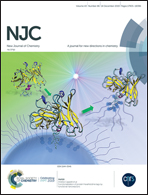A 9,9′-bifluorenylidene derivative containing four 1,1-dicyanomethylene-3-indanone end-capped groups as an electron acceptor for organic photovoltaic cells†
Abstract
A 9,9′-bifluorenylidene derivative, 2,2′,2′′,2′′′-([9,9′-bifluorenylidene]-2,2′,7,7′-tetrayltetrakis(4-octylthiophene-5,2-diyl))tetrakis(methanylylidene)tetrakis(3-oxo-2,3-dihydro-1H-indene-2,1-diylidene)tetramalononitrile (BF-TDCI4), was synthesized as an electron acceptor for organic photovoltaic cells. Its photophysical and electrochemical properties and thermal stability were investigated systematically. The photovoltaic devices were fabricated using PTB7-Th as the electron donor and BF-TDCI4 as the electron acceptor at various composition ratios. The optimized device exhibited a maximum power conversion efficiency of 4.35% with an open-circuit voltage of 0.87 V.



 Please wait while we load your content...
Please wait while we load your content...